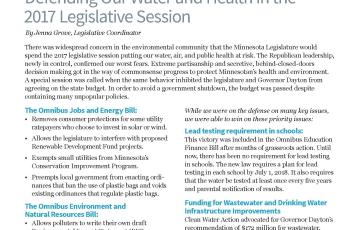Chesapeake Currents | Summer 2017 | Maryland Edition
The People’s Climate March in April was one of the landmark environmental events of the Trump era. More than 300,000 people traveled to DC from all over the country to march for jobs, justice, and climate action on the 100th day of
Minnesota Currents - Spring | Summer 2017
In this issue: Defending Our Water and Health in the 2017 Legislative Session; Water Action Day at the Capitol; Consumers are Detoxing Store Shelves; What You Can Do to Protect Our Water; and more!
Texas Currents - Spring | Summer 2017
In this issue: Trump’s Attacks on Landmark Environmental Laws; Texas Legislature Misses Opportunities on Environment; Sewage Discharges Above Edwards Aquifer; Bureau of Land Management Ignores Protests, Holds Fracking Auction Anchor; and more.
Letter to Congress: Please Oppose Imperiled Species Funding Cuts
Letter to Senate: Please Oppose David Bernhardt For Deputy Secretary of the Interior
May 17, 2017
Please Oppose David Bernhardt For Deputy Secretary of the Interior
Dear Senator:
We are writing to express our strong opposition to the recent nomination of David Bernhardt for deputy secretary of the Interior. After spending years lobbying for the oil and gas industry, big

